Section V: Special Chapter – Canada Firearms Centre
The Canada Firearms Centre (CAFC) is an operational service line within the National Police Services (NPS) of the RCMP. Under the RCMP, the CAFC has placed additional emphasis on providing direct support to all Canadian law enforcement agencies and international organizations by furnishing information and expertise relevant to firearms registration and licensing of individuals and businesses. As Canada’s national police Force, the RCMP will continue to uphold the Firearms Act and Part III of the Criminal Code.
The 2007-2008 reporting period continued to be a time of change and adaptation for the CAFC. Since being transferred to the RCMP in 2006, the CAFC underwent a significant number of organizational and operational changes. Although these changes positioned the program to benefit from synergies, they also presented challenges throughout the year.
In addition to the challenges related to the transition of the CAFC to the RCMP, the CAFC also relocated its headquarters staff. Throughout these changes, the CAFC continued to provide quality service, with minimal disruption to clients. The CAFC has completed 76 of its original 84 initiatives identified in its Transition Plan and is on target for the remaining eight.
For more information on the Canada Firearms Centre, visit: www.cfc-cafc.gc.ca/default_e.asp
During 2007-2008, the Director General of the CAFC reported to the Deputy Commissioner, National Police Services. CAFC Headquarters and the Canadian Firearms Registry are located in the National Capital Region. Regionally, Chief Firearms Officers’ (CFOs) operations are located within each province, with five administered by federally appointed CFOs and five administered by provincially appointed CFOs.
|
Planned Spending
(in millions) |
Total Authorities
|
Actual Spending
|
|
$70.4
|
$74.7
|
$62.3* |
|
Planned
|
Actual
|
Difference
|
| 318 | 284 |
34 |
Note: *Does not include $0.7M for “Refunds of amounts credited to revenues in previous years” shown in the 2006-2007 Public Accounts for CAFC as an adjustment to the Main Estimates authority of $74.7M and to total expenditures.
Results and Performance Framework
| Strategic Goal | |
| The risks to public safety from firearms in Canada and international communities are minimized. | |
| Expected Results and Indicators | |
|
Expected Results
|
Performance Indicators
|
| Reduced access to firearms for those who pose a threat to public safety | Licence revocations and refusals (for individuals and businesses) and associated reasons |
| Useful information made available for policing and law enforcement purposes | Queries to Canadian Firearms Registry On-line; affidavits produced |
| Safe use and storage of firearms | Participants in safety courses |
| Increased understanding and knowledge of program requirements by clients, community and Canadians | Renewal rate for licences; new clients; individual to individual firearms transfers |
| Activities and Outputs | |
| Registration, Licensing and Supporting Infrastructure: Administering efficient and effective registration, licensing and other non-registration activities | Policy, Regulatory, Communication and Portfolio Integration: An effective legislative, regulatory and policy framework in support of the Firearms Program |
| Activities | Outputs | Activities | Outputs |
| The Act is administered |
|
Program compliance is supported by effective public awareness activities |
|
| Efficient, client centered services and streamlined processes are in place |
|
Policies and programs are improved through more effective and informed policy development processes |
|
|
Border control of firearms is supported by effective monitoring mechanisms
|
|
Firearms Program forms an integral part of the national approach to secure Safe Homes and Safe Communities |
|
For the purposes of this reporting exercise and for compliance with the PAA, the CAFC’s strategic goal – The risks to public safety from firearms in Canadian communities and internationally are minimized – should be considered as its strategic outcome. The CAFC’s program activities are:
- Registration, Licensing and Supporting Infrastructure: Administering efficient and effective registration, licensing and other non-registration activities
- Policy, Regulatory, Communication and Portfolio Integration: An effective legislative, regulatory and policy framework in support of the Firearms Program
The expected results are listed at the organizational level instead of the program activity level, but will be reported on at the program activity level. Activities listed under each program activity should be considered to be the sub-activities.
Recommendations of the Auditor General
Action has been taken and, where applicable, initiatives put in place for each of the 12 recommendations made in the office of the Auditor General of Canada’s May 2006 report. Four of these recommendations have now been completed and the CAFC is tracking the progress of the outstanding items on a quarterly basis.
For more information, visit: www.oag-bvg.gc.ca/internet/English/parl_oag_200605_04_e_14961.html
Optimized the Public Safety Benefits
The CAFC contributed to public safety by administering the licensing of firearm users and owners and the registration of firearms. Public safety was optimized by requiring the completion of safety training for all new applicants for a firearms licence and by refusing and revoking licences to individuals who were considered a threat to public safety.
Continued Support for Legal Compliance
The CAFC promoted compliance with the law by providing useful information for policing and law enforcement purposes, by encouraging the renewal of firearm licences and by providing information about the requirements of the Firearms Act to public agencies, firearm owners and users and the general public.
Engaged the Public, Partners and Other Communities
In 2007-2008, the Director General of the CAFC led a strategic engagement initiative, personally delivering presentations to government and police officials. The CAFC also monitored its partners’ perceptions through the RCMP’s core survey. Finally, the CAFC administered an outreach program to Aboriginal communities.
Improved Service Delivery and Client Service
The CAFC conducted an efficiency review in 2007-2008 to address client service issues, such as registration backlog. Performance information for licensing and registration applications can be found in the “User Fees” table. For further information on the above-mentioned programs please visit: www.tbs-sct.gc.ca/est-pre/estime.asp
Increased Effectiveness of Internal Operations
The CAFC’s integration with the RCMP provided opportunities for cost savings in the medium to long term through the integration of corporate activities such as Finance, Human Resources, Communications and Information Technology systems. Most of the possible efficiency gains for the program have already been realized during the integration of the CAFC within the RCMP. The CAFC budget has been reduced by $13 million since 2006.
Reporting to Parliament and the Public/Management Accountability Framework
The CAFC’s reporting was fully integrated within the RCMP’s parliamentary reports such as Departmental Performance Reports, Reports on Plans and Priorities and Main Estimates.
Registration, Licensing and Supporting Infrastructure: Administering efficient and effective registration, licensing and other non-registration activities
Financial Resources
|
Planned Spending
(in millions) |
Total Authorities
|
Actual Spending
|
|
$66.5
|
$70.3
|
$49.9* |
|
Planned
|
Actual
|
Difference
|
| 297.4 | 227 |
70.4 |
Note: * Does not include $0.7M for “Refunds of amounts credited to revenues in previous years” shown in the 2006-2007 Public Accounts for CAFC as an adjustment to the Main Estimates authority of $74.7M and to total expenditures.
In order to possess and/or acquire firearms and ammunition in Canada, individuals older than 18 years of age must possess a valid Possession and Acquisition Licence (PAL). There are two other licences available to individuals within Canada:
- Possession Only Licence (POL): this type of licence was introduced to recognize long term ownership of firearms. A POL does not allow the acquisition of additional firearms but allows possession of firearms owned prior to December 1, 1998.
- Minor’s Licence: this licence is available to persons under 18 years old who wish to borrow non-restricted firearms for specific activities, such as target practice or hunting. Licenced minors cannot acquire firearms.
As of March 31, 2008, there were 1,863,356 valid individual firearm licences.
Chart 1: Valid Licences as of March 31, 2008
|
Province/Territory
|
POL
|
PAL
|
Minor
|
Total
|
| Alberta |
98,579
|
111,966
|
779
|
211,324
|
| British Columbia |
111,179
|
99,855
|
187
|
211,221
|
| Manitoba |
43,104
|
39,404
|
214
|
82,722
|
| New Brunswick |
57,519
|
21,975
|
97
|
79,591
|
| Newfoundland and Labrador |
36,083
|
34,222
|
148
|
70,453
|
| Nova Scotia |
56,272
|
23,427
|
1,091
|
80,790
|
| Northwest Territories |
1,303
|
3,856
|
31
|
5,190
|
| Nunavut |
161
|
2,536
|
1
|
2,698
|
| Ontario |
264,239
|
250,413
|
4,010
|
518,662
|
| Prince Edward Island |
4,933
|
2,285
|
2
|
7,220
|
| Quebec |
238,471
|
255,543
|
37
|
494,051
|
| Saskatchewan |
49,007
|
44,593
|
114
|
93,714
|
| Yukon |
1,852
|
3,817
|
51
|
5,720
|
| Total |
962,702
|
893,892
|
6,762
|
1,863,356
|
Data source: CFIS
Chart 2: Number of Firearms Licences Issued in 2007-2008
|
Licence Type
|
Total Issued in 2007-2008
|
|
Possession and Acquisition Licence
|
247,231
|
|
Possession Licence
|
139,609
|
|
Minor’s Licence
|
3,348
|
|
Total licences issued to individuals
|
390,188
|
|
Total licences issued to businesses
|
402
|
|
Total licences issued in 2007-2008
|
390,590
|
Data source: CFIS
In 2007-2008, the CAFC issued 390,188 firearms licences to individuals and 402 licences to businesses, as summarized in Chart 2, for a total of 390,590 licences.
Business Licences and Inspections
All businesses and organizations that produce, sell, possess, handle, display or store firearms or ammunition require a valid Firearms Business Licence. All employees of these businesses who are required to handle firearms on the job must have a valid firearms licence. All firearms in a business inventory must be authenticated by an approved verifier and be registered. Businesses must submit to periodic inspections by a Firearms Officer to confirm that they are storing firearms and conducting business in a safe and lawful manner.
The Firearms Act and regulations set out the safety standards for shooting clubs and ranges, ensuring the safety of patrons and the general public. These clubs and ranges are subject to inspections by Firearms Officers.
Expected Result: Safe Use and Storage of Firearms
Firearm Safety training ensures that firearm users and firearm owners learn to use, handle and store firearms in a safe manner. Since all licence holders are required to have successfully completed a firearm safety course, the CAFC considers that the expected result of safe use and storage of firearms is met.
Firearm education is a fundamental element of the CAFC which ensures that a firearm user received basic firearm safety training. To obtain a firearms licence, an applicant must have satisfied the requirements of the Canadian Firearms Safety Course (CFSC) or have been alternatively certified. The course ensures that all those who use a firearm are fully aware of their responsibility for the safe handling, transport and storage of firearms. During 2007-2008, 84,918 individuals took either the CFSC (70,293) or the Canadian Restricted Firearms Safety Course (CRFSC) (14,625). Note: the CFSC is a prerequisite for the CRFSC. Chart 3 summarizes the number of persons who completed the courses over the past six years.
Chart 3: Number of Individuals Who Have Completed Safety Training
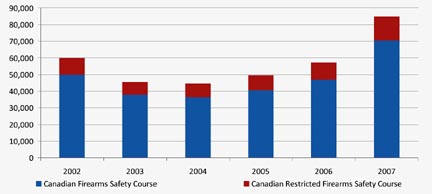
Note: The data is based on a calendar year and the graph does not include Quebec except for 2007.
Expected Result: Increased Understanding and Knowledge of Program Requirements by Clients, Community and Canadians
Compliance with the Firearms Act means that those in possession of firearms must have valid firearms licences and registration certificates, which supports frontline law enforcement and firearms safety efforts. The CAFC considers that the expected result of increased understanding and knowledge of program requirements by clients, community and Canadians has been mostly met.
A firearms licence for an individual is valid for five years, at which point the individual must apply to renew in order to retain one’s firearms. The CAFC has taken steps to streamline the renewal process. To promote compliance, a pre-populated renewal application is mailed to the client for completion 90 days prior to expiry. In 2007-2008, a total of 386,270 licences for individuals (POL and PAL) required renewal. The renewal rate averaged 71% in 2007-2008. Reasons for non-renewal included: no longer in possession, death, undeliverable renewal notice and non-compliance.
Expected Result: Reduced Access to Firearms for Those Who Pose a Threat to Public Safety
The CAFC reduces access to firearms for those who pose a threat to public safety by revoking and refusing licences. The CAFC considers that the expected result of reduced access to firearms for those who pose a threat to public safety was met.
Chart 4: Number of Licences Renewed by Individuals in 2007-2008
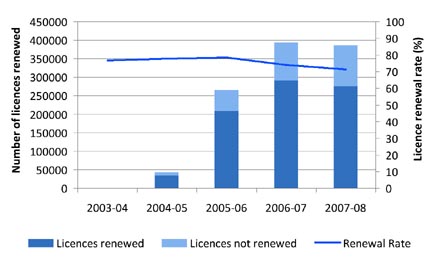
Data source: CFIS
Licence Refusals and Revocations
Licensing of an individual to possess firearms requires a variety of background checks. Applicants are screened to detect potential risks to public safety based on the initial application. Continuous eligibility screening is conducted through the life of the licence to identify any public safety risks that may arise over time.
During 2007-2008, 465 licence applications were refused and 1,756 licences were revoked.
Chart 5: Number of Licence Refusals and Revocations
|
Fiscal Year
|
Number of Refused Applications | Number of Licences Revoked |
|
2004-2005
|
435
|
2299
|
|
2005-2006
|
365
|
2197
|
|
2006-2007
|
432
|
1978
|
|
2007-2008
|
465
|
1756
|
Data source: CFIS
A Chief Firearms Officer (CFO) has the authority under the Firearms Act to refuse an application for a licence or revoke an issued firearms licence.
The most frequent reasons for refusing or revoking a licence are court-ordered prohibition/probation, risk to others and risk to self.
The Firearms Act requires the courts to notify the CFO of all firearms prohibition orders. Anyone applying for a firearms licence is screened/compared against prohibition and probation orders and, if an applicant is linked to any of these orders, they are refused a firearms licence. Individuals are then issued a notice with the particulars of the court order. If an individual is in possession of a firearms licence, they are instructed to turn in their licence and dispose of any of their registered firearms. As well, upon notification from the courts, the CFO will administratively revoke the individual’s licence. In addition, the Registrar of Firearms will revoke registration certificates of registered firearms and provide instructions to the individual on how to dispose of firearms and refuse any application in process to register firearms. Firearm prohibition and probation orders are captured in the Canadian Police Information Centre (CPIC) database and form part of the background and continuous eligibility checks. In 2007, approximately 208,581 individuals were prohibited from possessing firearms.
The CAFC also relies on information from municipal, provincial and federal courts in determining whether an individual is a potential threat to public safety. These court orders are typically civil in nature. A match against these court orders may result in the Firearms Officer conducting an investigation that may lead to a revocation or a change in licence conditions.
Chart 6: Persons Prohibited From Possessing a Firearm
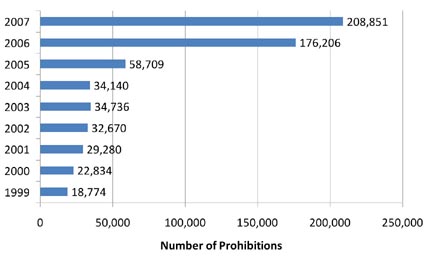
Note: Statistics available by calendar year only; commencing with 2006, the source of statistics for the number of persons prohibited from possessing a firearm is the CPIC system. In previous years, the source for statistical data was CFIS. The variance between the two source databases is that CPIC reflects mandatory court ordered prohibitions whereas CFIS reflects the number of individuals as entered into CFIS by CFOs. The increase is also attributable to prohibition being mandatory for certain drug offence charges and convictions.
The registration of a firearm provides links between firearms and their licenced owners, thereby enhancing owners’ accountability for safe storage and use of firearms. Recording firearm information helps police and other public safety officials carry out investigations efficiently and effectively by quickly tracing a firearm to its last lawful owner. This facilitates the recovery and return of lost or stolen firearms to their rightful owner.
As of March 31, 2008, a total of 7,235,699 firearms were registered to individuals and businesses throughout Canada (Chart 7).
Chart 7: Number of Firearms Registered By Class
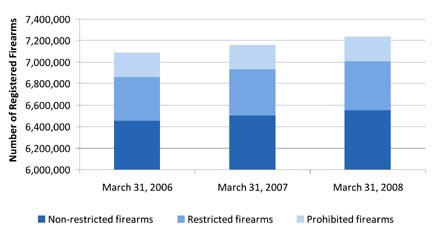
|
As of Date
|
Non-restricted firearms | Restricted firearms | Prohibited firearms | Total |
| March 31, 2006 | 6,454,316 | 406,319 | 225,038 | 7,085,673 |
| March 31, 2007 | 6,499,428 | 430,610 | 226,540 | 7,156,578 |
| March 31, 2008 | 6,549,670 | 457,414 | 228,615 | 7,235,699 |
Data source: CFIS
Chart 8: No. of Firearms Registered by Class and Province/Territory as of March 31, 2008
|
Province/Territory
|
Non-restricted firearms | Restricted firearms | Prohibited firearms | Total |
|
Alberta
|
780,027
|
74,390
|
24,717
|
879,134
|
|
British Columbia
|
752,661
|
80,872
|
30,985
|
864,518
|
|
Manitoba
|
315,298
|
15,574
|
6,602
|
337,474
|
|
New Brunswick
|
261,427
|
11,123
|
5,706
|
278,256
|
|
Newfoundland and Labrador
|
180,048
|
3,971
|
1,618
|
185,637
|
|
Nova Scotia
|
283,567
|
15,006
|
7,808
|
306,381
|
|
Northwest Territories
|
17,478
|
1,064
|
352
|
18,894
|
|
Nunavut
|
9,460
|
153
|
40
|
9,653
|
|
Ontario
|
1,992,725
|
171,558
|
90,328
|
2,254,611
|
|
Prince Edward Island
|
21,396
|
1,538
|
806
|
23,740
|
|
Quebec
|
1,527,316
|
58,112
|
49,944
|
1,635,372
|
|
Saskatchewan
|
365,599
|
22,222
|
9,162
|
396,983
|
|
Yukon
|
20,046
|
1,447
|
431
|
21,924
|
|
Other
|
22,622
|
384
|
116
|
23,122
|
|
Total
|
6,549,670
|
457,414
|
228,615
|
7,235,699
|
Data source: CFIS
One of the main policy objectives of Canada’s firearms legislation is to combat illicit trafficking and smuggling of firearms. Greater legislative controls over the importation and exportation of firearms are included in the Firearms Act. Separate offences for smuggling and trafficking are included in the Criminal Code. The CAFC has supported a number of international initiatives dealing with import, export and transit controls of firearms consistent with Canada’s legislative objectives.
The CAFC works closely with the Canada Border Services Agency (CBSA) to ensure compliance with the Firearms Act. The CBSA is committed to a responsible enforcement program while maintaining the quality of its border services. Non-residents are allowed to import firearms through a firearms declaration that is valid for up to 60 days. These are confirmed by customs officers at border crossings. As well, the CBSA seizes undeclared firearms at border crossings. Chart 9 identifies, by class, the number of firearms seized in 2007.
Chart 9: Firearms seized by CBSA in 2007 (by class)
|
Firearm Class
|
Number of firearms seized
|
|
Non-restricted
|
148
|
|
Restricted
|
180
|
|
Prohibited
|
334
|
|
Total firearms seized at the border
|
662
|
Note: CBSA statistics are only available by calendar year
Policy, Regulatory, Communication and Portfolio Integration: An Effective Legislative, Regulatory and Policy Framework in Support of the Firearms Program
|
Planned Spending
(in millions) |
Total Authorities
|
Actual Spending
|
|
$3.9
|
$4.4
|
$12.4* |
|
Planned
|
Actual
|
Difference
|
| 20.6 | 57.0 |
(36.4) |
Note: * Does not include $0.7M for “Refunds of amounts credited to revenues in previous years” shown in the 2006-2007 Public Accounts for CAFC as an adjustment to the Main Estimates authority of $74.7M and to total expenditures.
Strategic engagement of law enforcement and continuous improvement of data quality in the Canadian Firearms Information System (CFIS) are the first steps in supporting compliance with the law. Strategic engagement was led by the Director General of the CAFC, who personally delivered over 20 presentations to Government and Police officials across the country, resulting in a widespread recognition of the CAFC and a 50% increase in the use of the CFRO tool since January 2007. Communication initiatives were initiated throughout the year to keep clients and the public aware of not only the law, but also the program. Along with the strategic engagement initiative, communication initiatives including pamphlets, mailouts and manuals, were a key contributor to meeting this priority.
In addition to the strategic engagement of partners, the CAFC also included its own section in the RCMP Core Surveys sent to partners and stakeholders, promoting further engagement as well as increasing the visibility of the program. The results from the surveys will be analyzed to support further initiatives for the upcoming year.
Expected Result: Useful Information Made Available for Policing and Law Enforcement Purposes
The CAFC provides information in support of policing and law enforcement in two ways: first, through access to the Canadian Firearms Registry On-line (CFRO) for police agencies; and second, through the preparation of affidavits for the policing community and Crown prosecutors. The CAFC considers that the expected result of useful information made available for policing and law enforcement purposes was met.
Justice System Support
The CFRO is a subset of the Canadian Firearms Information System (CFIS). The system is available to Canadian police agencies via the CPIC system to assist them when responding to calls and conducting investigations. As a searchable application, police officers may query firearm related information such as the serial number or registration certificate number of a firearm, or the name, address and firearms licence number of an individual. The CFRO provides police with immediate access to the information they require in their investigational and operational activities. Ongoing support is provided to law enforcement agencies on a case-by-case basis. Chart 10 shows how the use of the CFRO tool continues to increase.
Chart 10: Canadian Firearms Registry On-line queries
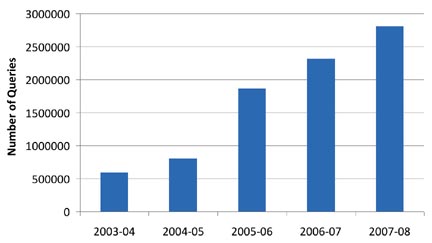
Data source: CFIS
Affidavit Requests
The CAFC assists the policing community and Crown Prosecutors by preparing affidavits that certify licensing or registration information related to individuals or firearms. Typically, affidavit requests are required to determine which firearms an individual has registered to them, or to determine if a given firearm is registered. This certification is based on data maintained and controlled by both the Chief Firearms Officer and the Registrar. In 2007, 3,557 affidavits were prepared. As shown in Chart 11, the number of affidavits produced for legal proceedings has continued to increase for the past five years.
The CAFC also operated a toll-free 1-800 Police Support telephone help line to assist the law enforcement community with firearm and licence related questions. In addition, the Centre also provides statistical and legislative information, on an ad-hoc basis, to law enforcement agencies across the country on both legal and illegal firearms.
Chart 11: Number of Affidavits Produced (by Canadian Firearms Registry only)
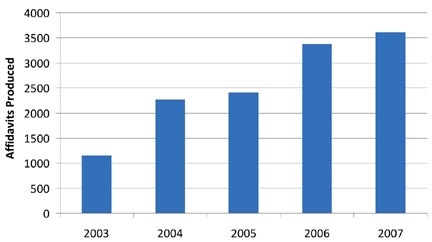
Note: Data only available by calendar year
Data source: Canadian Firearms Registry
Aboriginal Outreach
The Government of Canada is contributing directly to the safety of Aboriginal communities through firearms safety courses. These courses are culturally sensitive, lending local conditions and circumstances, yet maintaining national content and standards for the Canadian Firearms Safety course instruction and testing.
Financial Tables
The following tables represent financial information for the Canada Firearms Centre.
Table 1: Comparison of Planned to Actual Spending
| Program Activity ($ millions) |
Actual 2005-2006 |
Actual 2006-2007 |
2007-2008 | |||
| Main Estimates | Planned Spending | Total Authorities | Actual | |||
| Registration, Licensing and Supporting Infrastructure |
-
|
-
|
66.5
|
66.5
|
68.9
|
49.9
|
| Policy, Regulatory, Communication and Portfolio Integration |
-
|
-
|
3.9
|
3.9
|
5.8
|
12.4
|
| Total |
68.5
|
76.6
|
70.4
|
70.4
|
74.7
|
62.3
|
| Less: Non-respendable revenue |
(21.9)
|
(7.8)
|
N/A
|
(4.3)
|
N/A
|
(7.1)
|
| Plus: Cost of services received without charge |
3.6
|
4.2
|
N/A
|
4.2
|
N/A
|
3.4
|
| Total Departmental Spending |
46.6
|
73.0
|
70.4
|
70.3
|
70.3
|
58.6
|
| Full-time Equivalents |
371
|
357
|
342
|
318
|
361
|
284
|
Note:* Does not include $0.7M for “Refunds of amounts credited to revenues in previous years” shown in the 2006-2007 Public Accounts for CAFC as an adjustment to the Main Estimates authority of $74.7M and to total expenditures.
Table 2: CAFC Items included within RCMP’s Votes and Main Estimate
|
Vote or Statutory Item |
Vote or Statutory Wording
|
2007-2008 ($ millions) | |||
|
Main Estimates
|
Planned Spending
|
Total Authorities
|
Actual
|
||
| 45 | Operating expenditures – Non-Registration activities | 43.1 | 43.1 | 45.8 | 36.4 |
| 45 | Operating expenditures – Registration activities | 10.7 | 10.7 | 10.7 | 9.1 |
| 50 | Capital | 0.0 | 0.0 | 0.0 | 0.7 |
| 55 | Contributions | 12.7 | 12.7 | 14.1 | 12.7 |
| (S) | Contributions to employee benefit plans | 3.9 | 3.9 | 4.1 | 3.4 |
| (S) | Refunds of amounts credited to revenues in previous years | 0.0 | 0.0 | 0.7 | 0.7 |
| Total | 70.4 | 70.4 | 75.4 | 63.0 | |
- Date modified: